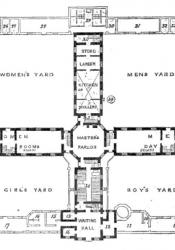Workhouses in England
Workhouses had been popular and in use in England from the 1600s, but the experienced a revolution in the 1800s. They shifted from being based in rectories and parishes to be a public service. At this time, they also underwent an architectural revolution. There were many men who created plans for workhouses and implemented them. However, there was one who many built their ideas after. Sampson Kempthorne created three basic workhouse shapes. First was the square, pictured here. Then the hexagonal, or “Y” shaped. Lastly, the 200-Pauper plan. Each of these were unique and made room for more and more people to be housed and work there. I am focusing on the square plan. This specific image is a floorplan by Kempthorne in 1835.
We see in this floorplan that men, women, and children were all separated from each other. Each had their own section and own places they were to stay. In the Women’s portion, they had a work room, washing room, and laundry. This seems to insinuate the duties women had in the workhouses. The men’s section had two work rooms. They didn’t have much more than that showing they had specific duties that were geared towards whatever work was being done in the workhouse. The children were also separated according to gender, and each had a work room. However, the children also had a place where they went to school.
One of the most interesting parts of the workhouses, to me, is this fact that they were separated by gender and age. This implies an interesting contrast between Victorian values. As we’ve discussed, Victorians were obsessed with family and the ideal of the perfect family. It seems very un-Victorian that families would be separated in a place like this. However, the opposing view is the Victorian concern of incest within the family of the poor. There seems to be a conflict here in the workhouse between what Victorian values are and what they mean to the people. The Victorian era is full of contrasts and contradictions. Workhouses show this in an intriguing way. To Victorians, family and God was supreme. Yet, in workhouses we see families split up and separated. The people who could actually help with issues ignore the poor, those who are sentenced to debtor’s prisons and workhouses. This is not a very Christian response to those in need. Overall, workhouses represent to me, the face of Victorian England, below the surface there is more happening.
Higginbotham, Peter. "Workhouse Architecture." The Workhouse: The Story of an Institution, 2021. http://www.workhouses.org.uk/buildings/.

